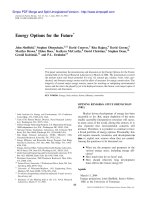Energy Options for the Future phần 2 docx
Bạn đang xem bản rút gọn của tài liệu. Xem và tải ngay bản đầy đủ của tài liệu tại đây (626.27 KB, 10 trang )
In the nuclear area there are a number of pro-
grams to enhance the performance of existing
plants and to develop improved fuel cycles
and advanced reactors see talks by McCarthy,
section ‘‘Nuclear Energy’’ and Christian, sec-
tion ‘‘Nuclear Industry Perspective.’’
In the fusion energy area, the U.S. has re-
joined the International Thermonuclear
Experimental Reactor activity—see Dean
talk, section ‘‘Paths to Fusion Power.’’
Sequestration of CO
2
There is a large potential for the sequestration of
CO
2
in a variety of storage options—gas and oil
reservoirs, coal seams, saline aquifers, the deep ocean,
and through conversion to minerals and by bio-
conversion, see Figure 5.
CCTP Process
The CCTP process is involved in Federal R&D
portfolio review and budget input. It has a strategic
plan and a working group structure in the areas of
Energy production,
Energy efficiency,
Sequestration,
Other gases,
Monitoring and measurement, and
Supporting basic research.
It has issued a competitive solicitation/RFI
seeking new ideas.
The keys to meeting the President’s goals are:
leadership in climate science,
leadership in climate-related technology,
better understanding of the potential risks of
climate change and costs of action, Robust
set of viable technology options that address
energy supply and efficiency/productivity,
integrated understanding of both science and
technology to chart future courses and ac-
tions,
global approach… all nations must partici-
pate.
A GLOBAL PERSPECTIVE OF COAL & NAT-
URAL GAS: RITA BAJURA (NETL)
Coal
Reserves and Use
The world’s recoverable reserves of coal are
1083 billion tons, a 210 year supply a t the current
annual consumption. The United States has the
largest amount of these reserves—25%. Russia has
16%, China 12%, and India and Australia about
9%.
Increasingly, coal is used for electricity pro-
duction, 92% of 1.1 billion tons in the U.S. in 2002
and a projected 94% of 1.6 billion tons in 2025.
g
Fig. 6.
73Energy Options for the Future
The bulk of the coal-fired electrical capacity of
330 MWe in the U.S. was built between 1966 and
1988. Similarly in the world, usage in electricity
production was 66% of 5.3 billion tons in 2001, and
a projected 74% of 5.9 billion tons in 2025, as
illustrated in Figure 6.
While the DOE-EIA predicts that oil and
natural gas prices will rise over the next 20 years,
it predicts that coal prices will remain constant. A
major factor affecting coal prices has been the
steady improvements in coal productivity across the
globe, with a doubling of output per miner per year
from 1990 to 1999. Australia, the U.S. and Canada
lead with a productivity of 11,000 to 12,000 tons
per miner per year. Productivity in de veloping and
transitional countries lags that in developed coun-
tries.
Coal mining safety has been improved a lot in
the U.S. In 1907 there were 3200 mine deaths, in
2003 there were 30. However, this is still an issue in
developing and transitional countries e.g., in China
there were 7000–10,000 deaths per year in coal
mines.
Environmental Concerns
There are numerous environmental impacts in
the mining and use of coal, as illustrated in Figure 7.
Regulators and industry are working to reduce these
impacts through: improved permitting, reclamation,
groundwater management, and utilization of coal
mine methane.
Contaminant emissions from fossil fired U.S.
power plants, relative to fossil use, are down sharply
as shown in Figure 8.
Coal plants operate under a complex system of
environmental regulations that relate to the emissions
of particulate matter, SO
x
, and NO
x
. The cost of
removal of various percentages of these materials is
shown in Table 4.
Mercury emissions are also a concern and the use
of coal is the largest U.S emitter, contributing about
2% of world emissions. Today, there is no commer-
cially available technology for limiting mercury emis-
sions from coal plants. There is an active DOE-funded
research effort. There are a number of field sites where
mercury control is being tested. Co-control may be
able to remove 40–80% Hg with bitum inous coal but
control will be much more difficult with low-rank
coals. U.S. regulations are likely to be promulgated in
the period from 2008 to 2018.
Climate Change. CO
2
from energy use is a major
contributor—83%, to green house gas warming
potential. The coal contribution is 30%. Stabilizing
CO
2
concentrations (for any concentration between
350 and 750 ppm) means that global net CO
2
emissions must peak in this century and begin a
long-term decline ultimately approaching zero. The
pre-industrial level was 280 ppm. The technological
carbon management options are:
Reduce carbon intensity using renewable
energies, nuclear, and fuel switching.
Fig. 7.
74 Sheffield et al.
Improve efficiency on both the demand side
and supply side.
Sequester carbon by capturing and storing it
or through enhancing natural processes.
All of the options need to supply the energy
demand and address environmental objectives.
Considerable improvements in efficiency are
possible for coal plants, as shown in Figure 9.
The DOE’s 2020 goal is 60%. The integrated
gasification combined cycle (IGCC) plant is a prom-
ising pathway to ‘‘zero-emission’’ plants. It has fuel
and product flexibility, high efficiency, is sequestra-
tion ready and environmentally superior. It can
produce a concentrated stream of CO
2
at high
pressure, reducing capital cost and efficiency penal-
ties. It is being demonstrated at the Wabash River
plant, which achieved 96% availability and won the
1996 powerplant of the year award, and at the Tampa
electric, which won the 1997 award. The issues for the
IGCC are that a 300 MWe plant costs 5–20% more
than pulverized coal units however, economics for a
600 MWe plant appear more favorable. They take a
longer shakedown time to achieve high availability
and they suffer from the image of looking like a
chemical plant. Worldwide there are 130 operating
Fig. 8.
Table 4.
75Energy Options for the Future
gasification plants with 24 GWe IGCC-equivalent,
with more underway.
Sequestration. There are numerous options for
separation and storage of CO
2
including unmineable
coal seams, depleted oil and gas wells, saline
aquifers, and deep-ocean injection. Sequestration
can also be achieved through enhancing natural
processes such as forestation, use of wood in
buildings, enhanced photosynthesis and iron or
nitrogen fertilization of the ocean. The potential
capacity for storage is very large compared to
annual world emissions. There remain concerns
about the possibility of leaks from some forms of
sequestration, but it has been demonstrated e.g., in
the Weyburn CO
2
project, in which CO
2
, produced
in the U.S., is piped to Canada to support enhanced
oil recovery; and in the Sleipner North Sea project,
in which a mil lion tonnes a year of CO
2
are removed
from natural gas and sequestered in a saline aq uifer
under the sea. The costs, including separation,
compression, transport, and sequestration, appear
reasonable. The incremental average impact on a
new IGCC is expected to be a 25% increase in cost
of electricity (COE) relative to a non-scrubbed
counterpart. DOE’s goal is to reduce this increment
to <10%. Note that retrofitting CO
2
controls,
unless a plant was designed for it would be
expensive. There is a diverse research portfolio with
>60 projects and a $140 M portfolio. There is
strong industry support with a 36% cost share.
From AEP, Alstom, BP, Chevron Texaco, Consol,
EPRI, McDermott, Shell, TVA, and TXU. The
sequestration option could remove enough carbon
from the atmosphere to stabilize CO
2
concentra-
tions, be compatible with the existing energy struc-
ture, and be the lowest cost carbon management
option.
FutureGen: A Global Partnership Effort
This effort is a ‘‘one billion dollar, 10-year
demonstration project to create the world’s first coal-
based, zero-emission electricity and hydrogen plant’’
President Bush, February 27, 2003. It has broad U.S.
participation and DOE contemplates implementation
by a consortium. There is international collaboration
including a Carbon Sequestration Leadershi p Forum.
An industry group has anno unced the formation of a
FutureGen Consortium. The charter members repre-
sent about 1/3 of the coal-fired utilities and about 1/2
of the U.S. coal industry—Americxan Electric Power,
CINEnergy, PacificCorp, TXU (Texas Utilities), and
CONSOL, Kennecot Energy, North American Coal,
Peabody Energy, RAG American Coal Holding.
FutureGen opens the door to ‘‘reuse’’ of coal in
the transportation sector through producing clean
diesel fuel with Fischer-T ropsch synthesis. Also,
hydrogen may be produced, by a shift process and
separation with sequestration of the CO
2
for use in
fuel cells and IC engines.
g
Fig. 9.
76 Sheffield et al.
Why Coal is Important
Coal remains the largest energy source for power
generation. It is a potential source for transportation.
There are abundant reserves—particularly in the U.S.
It contributes to our energy security. It had relatively
low and stable prices. It has environmental impacts
but, increasingly, the technology is becoming avail-
able to address them.
Natural Gas
Resources and Use
The world’s proven gas reserves of 5.500 Tcf
could supply the current annual usage for 62 years.
The largest reserves are in Iran, Qatar and Russia.
However, there is more gas than the proven reserves
including unconventional sources such as coalbed
methane, tight gas, shale gas and methane hydrates
for which the production is more difficult and will be
impacted by technology.
In the U.S., 22.8 Tcf was used in 2002, 32% in
industry and 24% for electricity production. The
DOE-EIA predicts a usage of 31.4 Tcf in 2025 with
33% in industry and 27% for electricity. Worldwide
usage in 2001 was 90.3 Tcf with 23% in industry and
36% for electricity increasing to 175.9 Tcf in 2025
with 46% for electricity. The usage is illustrated in
Figure 10.
The EIA predicts that gas prices are likely to stay
at the 2003 average of $5.50 per Mcf through at least
2025. In fact, U.S. gas prices are quite volatile with
±3% moves on 32 days of the year. Nevertheless,
there has been construction of 200 GWe of new gas-
fired capacity since 1998 in the U.S., despite a
significant decrease in U.S. production since the peak
in the 1970s. In fact while wells are being drilled more
quickly there has been a decline in production from
the lower-48 states. This decline is reflected in the
lowering projections of the EIA. The shortfall has
been made up from imports from Canada, Mexico
and from shipments of LNG, but reduced imports
from Canada are now forecast.
An 18-month comprehensive assessment of
North American supply and demand has been
made with broad industrial involvement—‘‘Balanc-
ing Natural Gas Policy: Fueling the demands of a
growing econ omy,’’ National Petroleum Council,
September 2003. The higher prices reflect a funda-
mental shift in the supply/demand balance. The
traditional North American gas producing areas
can only supply 75% of the projected demand and
at best sustain a flat production. New larger-scale
resources (LNG, Arctic) could meet 20–25% of
demand. But they have higher cost, long lead-times
and developmental barriers. The technical resources
are impacted by access restrictions to the Pacific
offshore (21 Tcf), the Rockies (69 Tcf), The Eastern
Gulf Shelf and Slope (25 Tcf) and the Atlantic
offshore Shelf and Slope (33 Tcf)—6 to 7 years of
U.S. usage. Projections for future U.S. use are
shown in Figure 11.
Fig. 10.
77Energy Options for the Future
Liquid Natural Gas (LNG)
LNG will supp ly an estimated 15% of U.S.
demand by 2025. Worldwide it is expected that LNG
capacity will increase from 6 Tcf per year in 2003 to
35 Tcf in 2030. In 2003, there were 17 liquefaction
terminals, 40 regasification terminals, 151 tankers with
55 under construction, and 12 exporting and 12
importing countries. Japan alone imports 1/2 of the
world’s production. In the U.S., there are 4 terminals,
32 active proposals amounting to 15 Tcf if built,
but none are under construction and there is a
7-year construction period. Numerous global LNG
liquefaction projects are competing to meet the grow-
ing demand. Qatar has massive reserves of
900 Tcf—more than the entire U.S. The higher gas
prices are leading to the development of this very large,
low-cost reserve with large-scale LN G and gas-to
liquids facilities. As the LNG plant size has increased,
improved technology has led to falling costs. Safety
remains a concern as there have been serious accidents
at facilities. Nevertheless, in its 40-year history, with
33,000 tanker voyages, there have been no major
accidents. There is a dramatically changed perspective
on infrastructure security in regard to the facilities
since some of the facilities are close to major popula-
tion centers such as Boston. Solutions to this concern
include citing the facilities off-shore.
Environment
Technology is reducing the environmental
impact of natural gas and oil supply. Fewer wells
with a smaller footprint are needed to add the same
level of reserves. There are lower drilling waste
volumes, lower produced water volumes, and
reduced air pollutants and greenhouse gas emis-
sions. There is a greater protection of unique and
sensitive environments.
Methane Hydrates
Methane hydrates consist of methane trapped
in ice in which the methane density is comparable to
liquid methane. They form when the temperature is
cold enough at the given pressure e.g., in the tundra
of the north or in the seabed at sufficient depth. For
the longer term they may be a promising source of
methane. The international Mallik Gas Hydrate
project in the Mackenzie Delta of Canada has the
first dedicated hydrates test wells. And depressur-
ization has proved more effective than heating in
extracting the methane. The estimated amount of
such hydrates is huge and they are widely dispersed
as shown in Figure 12.
Stranded Gas
A large amount of gas exists as so-called
‘‘stranded gas’’ i.e., isolate or small. Options for this
gas are to reinject it, flare it, expand local uses in
petrochemicals and basic industries such as alumi-
num. If economic build a pipeline. Alternatively,
convert it to liquids, LNG or electricity.
Fig. 11.
78 Sheffield et al.
Gas-fired Distributed Generation
The advent of fuel cells and efficient engines
including recipr ocating engines, small turbines,
micro-turbines has enhanced the attractiveness of
distributed generation that can defer new capacity,
relieve transmission congestion, enhance reliability,
improve efficiency, and promote the green image.
Future
In the natural gas-coal competition it is expected
that coal will win for short-term dispatch and gas for
long-term capacity share, because of an increasing
desire for energy security. It is forecast that there will be
a surge in coal capacity starting in 2010 in the U.S.
There areproposals for 94 new plants with acapacity of
64 GWe. Worldwide there are proposals for thousands
of GWe of new capacity, including 1400 GWe of coal
technologies as shown in Figure 13. The estimated
global investment required is 16.2 trillion dollars over
the next three decades (IEA).
Therefore it is expected that coal and natural gas
will continue to be a major part of the U.S. and
global energy mix for at least 50 years. Maintaining
fuel diversity and flexibility is important for price
stability and continued economic growth. LNG use
will increase; meeting a 5 Tcf demand will be chal-
lenging. Carbon sequestration at the scale envisioned
is still a young technology. Near-zero emission
technologies (SO
x
,NO
x
,CO
2
, mercury) will be
necessary to secure a long-term future for coal.
RUNNING OUT OF AND INTO OIL: ANALYZ-
ING GLOBAL OIL DEPLETION AND TRANSI-
TION THROUGH 2050: DAVID GREENE (ORNL)
WITH JANET HOPSON AND JIA LI (U. TEN-
NESSEE), HTTP://WWW-CTA.ORNL.GOV/
CTA/PUBLICATIONS/PUBLICA-
TIONS_2003.HTML
Introduction
In regard to the question ‘‘are we running out of
oil,’’ the pessimists aka ‘‘geologists’’ argue that
geology rules, note that discovery lags production
and that peaking not running out matters, and expect
a peak by 2010 (conventional oil).
The optimists aka ‘‘economists’’ argue that
economics rules, expect that the rate of technological
progress will exceed the rate of de pletion and that the
market system will provide incentives to expand, and
redefine resources.
The questions to answer if one took the opti-
mists’ viewpoint, but quantified it, are:
How much oil remains to be discovered?
How fast might technology increase recovery
rates?
How much will reserves grow?
How fast will technology reduce the cost of
unconventional sources?
How much unconventional oil is there and
where is it?
g pp ypp ()
Fig. 12.
79Energy Options for the Future
In this approach, there are no Hubbert’s bell-
shaped curves for production, and no geological
constraints on production rates. However, costs do
rise with depletion!
The Resource/Production ratio limits expansion
of production. It is analogous to a limit based on the
life of cap ital, but there is no explicit calculation of
capital investment.
There are no environmental/social/political
constraints on production—ANWAR, etc. are fair
game.
What is Oil?
Conventional oil is defined here as liquid
hydrocarbons of light and med ium gravity
and viscosity, in porous and permeable res-
ervoirs, plus enhanced recovery and natural
gas liquids (NGLs).
Unconventional oil is defined as deposits of
density > water (heavy oil), viscosi-
ties >10,000 cP (oil sands) and tight forma-
tions (shale oil).
Liquid fuels can be made from coal or natu-
ral gas (not considered here).
Many estimates have been made of the amount
of oil as illustrated in Figure 14. Conventional oil:
The USGS (2000) estimates a mean ultimate recovery
of conventional oil of 3345 billion barrels (bbls) with
a low of 2454 bbls (95% probability) and high of
4443 bbls (5% probability), with cumulative produc-
tion to date of 717 bbls.
If there were no growth beyond the 2000
production level, production could continue for a
50 years at the mean level. With a 2% growth rate,
peaking might occur around 2025.
Unconventional oil: A comparable amount to
remaining conventional oil is estimated to exist. A
large part of it is shale oil in the U.S. and oil sands in
Canada and Venezuela.
In contrast, the pe ssimists estimate 2390 bbls of
conventional oil and 300 bbls of unconventional oil.
Modeling of Future Demand and Supply
A computer model has been constructed to
explore how oil production might evolve up to 2050
under the projections for oil demand in the en ergy
scenarios of the IIASA/WEC (2002).
The reference scenario A1 represents ‘‘business-
as-usual". Oil consumption rises from about
3.9 Gtoe/a to about 8.8 Gtoe/a (1 tonne of oil
equivalent (toe) = 7.3 bbls), much of the future
growth is predicted to be in the developing world,
see Figure 15.
An ‘‘ecologically driven scenario" C1 was also
considered. In this scenario, oil consumption peaks at
about 5.3 Gtoe/a around 2020 and then declines
towards today’s usage.
Both optimistic and pessimistic assumptions
about oil resources were used. A risk analysis was
Fig. 13.
80 Sheffield et al.
carried out by defining the key parameters below as
random variables: Prices for the different types of oil
were taken to be—conventional oil $20/bbl, heavy oil
and bitumen $15/bbl or $25/bbl, and for shale oil
$40/bbl or $90/bbl.
Various assumptions were made about the growth
rate of Middle East production, technological change,
recovery/reserve expansion, speculative resources
parameters, target R/P ratio, and supply and demand
parameters such as short run demand elasticity, short
run supply elasticity and the adjustment rate.
Depending on the assumptions the trade-off
between the production of conventional and uncon-
ventional oil varied. So, if lower cost oil from Middle
East production continued at a high level the demand
for higher cost unconventional oil would be
low—conventional oil production peaked earlier. If
Middle East production was lower then oil prices
were higher making unconventional oil more com-
petitive—conventional oil production peaked later.
In the reference case, with the mean USGS data,
the Rest of the World (ROW) conventional oil
g
Fig. 14.
Fig. 15. The average growth of oil use in the world is 1.9%/yr.
81Energy Options for the Future
production peaks before 2030, with a mean year of
2023. In the pessimistic case, the mean year for
peaking of ROW conventional oil is 2006. The total
world conventional oil peaks between 2040 to after
2050. The year of peaking depends strongly on the
rate of expansion of Middle East production and the
resulting production of unconventional oil. Under
the median assum ptions, unconventional oil must
expand rapidly after 2020, see Figure 16.
The depletion of all kinds of oil resources from
the model is shown in Figure 17.
Rapid expansion of heavy oil and oil sands is
needed to allow world oil use to continue to grow.
Large amou nts of shale oil might also be produced,
mainly in the U.S., but the ability to achieve
estimated production levels is more uncertain.
US petroleum production and imports continue
to increase during this period, but the fraction from
U.S. production increases owing to the U.S. produc-
tion of unc onventional oil.
The Middle East could maintain a dominant
position in its share of total production through 2050.
Even in the low growth scenario, the ROW
conventional oil would peak around 2017.
Conclusions
Present trends imply that ROW conventional oil
will peak between 2010 and 2030. The rate of produc-
tion is likely to decrease after 2020 in any case. The
transition to unconventional oil may be rapid: 7–9%/
year growth. First supplies will be from Venezuela,
Canada, and Russia. Vast quantities of shale oil (or
liquids from coal and NG) may be needed before 2050.
Caveats on the model are that it does not include
geologic constraints on production rates; relies on
target resource-to-production ratios; does not include
environmental or political constraints; does not
include coal- or gas-to liquids; the resource estimates
of unconventional oil are weak; and scenario were
used, not market equilibrium-based modeling of oil
demand.
THE POTENTIAL FOR ENERGY EFFICIENCY
IN THE LONG RUN: MARILYN BROWN
(ORNL)
Introduction
The key points are that:
A large economic potential for energy
efficiency exists from deploying current
technologies.
Technology advance will further expand this
potential.
Energy efficiency can moderate the need for
new energy supplies and:
– reduce greenhouse gas emissions,
– improve air quality,
– strengthen electric reliability and energy
security.
g gy g
Fig. 16. Under median assumptions, unconventional oil production must expand rapidly after 2020.
82 Sheffield et al.









